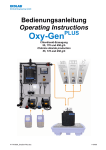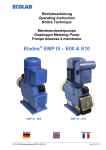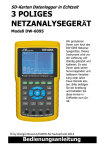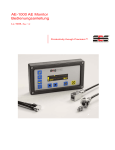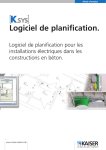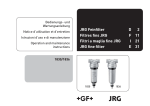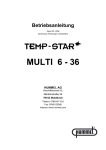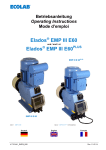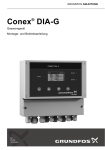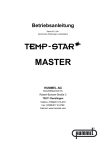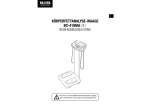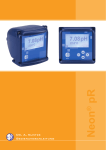Download 417101376 ClO2 Dosierstationen
Transcript
Bedienungsanleitung Instruction Manual Chlordioxid (ClO2) Dosierstation Chlorine dioxide (ClO2) Metering Station 16 l/h 54 l/h 210 l/h 417101376_ClO2_Dosierstationen.doc Rev. 1-12.07 Inhaltsverzeichnis 1 Allgemeines ....................................................................................................................4 1.1 1.2 1.3 Normen ....................................................................................................................................... 4 Gewährleistungsumfang............................................................................................................... 4 Kontaktadresse / Hersteller: ......................................................................................................... 4 2 Sicherheit .......................................................................................................................5 2.1 2.2 2.3 2.4 Sicherheitshinweise ..................................................................................................................... 5 Hervorhebungen .......................................................................................................................... 5 Spezielle Sicherheitshinweise bei Wartungs- und Reparaturarbeiten .............................................. 5 Umgang mit wässrigen Chlordioxid-Lösungen ............................................................................... 5 2.4.1 2.4.1.1 2.4.1.2 2.4.1.3 2.4.2 2.4.2.1 2.4.2.2 2.4.3 2.4.4 Allgemeiner Umgang .................................................................................................................................... Lagerung ..................................................................................................................................................... Maßnahmen bei Verschütten, Auslaufen, Gasaustritt und Entsorgung ............................................................ Maßnahmen bei Bränden ............................................................................................................................. Gesundheitsschutz ...................................................................................................................................... MAK-Wert Chlordioxidgas ............................................................................................................................ Persönliche Schutzausrüstung...................................................................................................................... Gesundheitsgefahren ................................................................................................................................... Erste Hilfe ................................................................................................................................................... 3 4 Lieferumfang ..................................................................................................................7 Gerätebeschreibung .......................................................................................................9 4.1 4.2 4.3 4.4 4.5 Ausführung 16 l/h ........................................................................................................................ 9 Ausführung 54 l/h ........................................................................................................................ 9 Ausführung 210 l/h ...................................................................................................................... 9 Geräteaufbau ............................................................................................................................ 10 Bedien- und Anzeigeelemente .................................................................................................... 10 5 Montage / Installation ...................................................................................................11 5 5 5 6 6 6 6 6 6 5.1 Installation ................................................................................................................................ 11 5.1.1 5.1.2 5.1.3 5.1.3.1 5.1.3.2 5.1.4 5.1.4.1 5.1.4.2 5.1.5 5.1.6 5.1.6.1 5.1.6.2 5.1.7 5.1.8 5.1.9 5.1.10 5.1.10.1 5.1.10.2 5.1.10.3 5.1.10.4 5.1.10.5 5.1.10.6 Auffangwanne.............................................................................................................................................11 Pumpe .......................................................................................................................................................12 Saugleitung ................................................................................................................................................12 Typ 16 l/h bzw. 54 l/h ..................................................................................................................................12 Typ 210 l/h .................................................................................................................................................13 Mehrfunktionsventil .....................................................................................................................................14 Typ 16 l/h bzw. 54 l/h ..................................................................................................................................14 Typ 210 l/h .................................................................................................................................................15 Dosierventil ................................................................................................................................................16 Verdrahtung der Pumpe ..............................................................................................................................17 Spannungsversorgung ................................................................................................................................17 Freigabesignal (Pump Enable) und Impulseingang der Pumpe ......................................................................17 Aktivkohlefilter ............................................................................................................................................19 Niveaugeber ...............................................................................................................................................19 Leckageschalter .........................................................................................................................................20 Externe elektrische Anschlüsse ...................................................................................................................21 Externe Spannungsversorgung ....................................................................................................................22 Produktionsfreigabe für die Halox ClO 2 -Erzeugungsanlage ...........................................................................22 Wasserzählereingang / -ausgänge ...............................................................................................................22 Externes Freigabesignal (optional) ..............................................................................................................22 Alarmausgang (optional) .............................................................................................................................22 PL U S ) (optional) .............................................................23 Dosiermengenüberwachung mit Ovalradzähler (OGM 6 Inbetriebnahme .............................................................................................................24 6.1 6.2 6.3 Halox ClO 2 -Erzeugungsanlage ................................................................................................... 24 ClO 2 -Dosierstation ..................................................................................................................... 24 Erstbefüllung ............................................................................................................................. 24 7 Betrieb der ClO 2 -Dosierstation .....................................................................................25 7.1 Betriebszustände, Schaltausgänge und Alarm............................................................................. 25 8 Wartung ........................................................................................................................26 8.1 Verschleißteile .......................................................................................................................... 26 8.1.1 8.1.2 Typ 16 l/h / 54 l/h........................................................................................................................................26 Typ 210 l/h .................................................................................................................................................26 8.2 Ersatzteile................................................................................................................................. 27 9 10 Fehler-, Alarm- und Statusmeldungen .........................................................................28 Zubehör ........................................................................................................................29 10.1 10.2 10.3 Photometer zur Schnellbestimmung von Chlordioxid ................................................................... 29 Kontaktwassermesser / Magnetisch Induktiver Durchflussmesser ................................................ 29 Statischer Mischer ..................................................................................................................... 29 11 12 Technische Daten .........................................................................................................30 Konformitätserklärung .................................................................................................31 417101376_ClO2_Dosierstationen.doc -2- Rev. 1-12.07 Table of contents 1 General Points ..............................................................................................................32 1.1 1.2 1.3 Standards ................................................................................................................................. 32 Extent of Warranty..................................................................................................................... 32 Contact Address/Manufacturer: .................................................................................................. 32 2 Safety ............................................................................................................................33 2.1 2.2 2.3 2.4 Safety Information ..................................................................................................................... 33 Emphases ................................................................................................................................. 33 Special Safety Instructions for Maintenance and Repair Work...................................................... 33 Handling Aqueous Chlorine Dioxide Solutions ............................................................................. 33 2.4.1 2.4.1.1 2.4.1.2 2.4.1.3 2.4.2 2.4.2.1 2.4.2.2 2.4.3 2.4.4 General Handling Instructions .....................................................................................................................33 Storage ......................................................................................................................................................33 Spillage, Leakage, Gas Escape, and Disposal ..............................................................................................33 Fire ............................................................................................................................................................34 Health Protection ........................................................................................................................................34 MAC Value of Chlorine Dioxide Gas.............................................................................................................34 Personal Protective Equipment ....................................................................................................................34 Health Risks ...............................................................................................................................................34 First Aid .....................................................................................................................................................34 3 4 Scope of Supply ...........................................................................................................35 Unit Description............................................................................................................37 4.1 4.2 4.3 4.4 4.5 16 l/h Design ............................................................................................................................. 37 54 l/h Design ............................................................................................................................. 37 210 l/h Design ........................................................................................................................... 37 Unit Design ............................................................................................................................... 38 Control and Display Elements .................................................................................................... 38 5 Assembly/Installation ...................................................................................................39 5.1 Installation ................................................................................................................................ 39 5.1.1 5.1.2 5.1.3 5.1.3.1 5.1.3.2 5.1.4 5.1.4.1 5.1.4.2 5.1.5 5.1.6 5.1.6.1 5.1.6.2 5.1.7 5.1.8 5.1.9 5.1.10 5.1.10.1 5.1.10.2 5.1.10.3 5.1.10.4 5.1.10.5 5.1.10.6 Collecting Tray ...........................................................................................................................................39 Pump .........................................................................................................................................................40 Suction Line ...............................................................................................................................................40 16l/h and 54l/h Types..................................................................................................................................40 210 l/h Type ...............................................................................................................................................41 Multi-Function Valve ...................................................................................................................................42 16l/h and 54l/h Types..................................................................................................................................42 210 l/h Type ...............................................................................................................................................43 Metering Valve ...........................................................................................................................................44 Pump Wiring ...............................................................................................................................................45 Power Supply .............................................................................................................................................45 ‘Pump Enable’ Signal and Pump Pulse Input ................................................................................................45 Active Carbon Filter ....................................................................................................................................47 Level Sensor ..............................................................................................................................................47 Leakage Switch ..........................................................................................................................................48 External Electrical Connections ...................................................................................................................49 External Power Supply ................................................................................................................................50 Product Release for Halox ClO 2 Generator ...................................................................................................50 Water Meter Inputs/Outputs.........................................................................................................................50 External Enable Signal (Optional) ................................................................................................................50 Alarm Output (Optional) ..............................................................................................................................50 P L US ) (Optional) .....................................................51 Metering Quantity Monitoring with Oval Gear Meter (OGM 6 Startup ..........................................................................................................................52 6.1 6.2 6.3 Halox ClO 2 Generator ................................................................................................................ 52 ClO 2 Metering Station ................................................................................................................ 52 First Filling ................................................................................................................................ 52 7 Operating the ClO 2 Metering Station ............................................................................53 7.1 Operating States, Relay Outputs, and Alarm ............................................................................... 53 8 Maintenance .................................................................................................................55 8.1 Wearing Parts ........................................................................................................................... 55 8.1.1 8.1.2 16l/h and 54l/h Types..................................................................................................................................55 210 l/h Type ...............................................................................................................................................55 8.2 Spare Parts ............................................................................................................................... 56 9 10 Error, Alarm, and Status Notifications .........................................................................57 Accessories ..................................................................................................................58 10.1 10.2 10.3 Photometer for Quick Measurement of Chlorine Dioxide .............................................................. 58 Contact Water Meter/Magnetic-Inductive Flow Meter ................................................................... 58 Static Mixer ............................................................................................................................... 58 11 12 Technical Data ..............................................................................................................59 Conformity Declaration ................................................................................................60 417101376_ClO2_Dosierstationen.doc -3- Rev. 1-12.07 1 Allgemeines Dieses Technische Handbuch enthält alle Anweisungen zur Installation, Inbetriebnahme, Wartung und Reparatur der ClO2-Dosierstationen. Die Sicherheitshinweise und Hervorhebungen sind in jedem Fall zu beachten! 1.1 Normen Die ClO2-Dosiersstationen halten die geforderten Schutzziele ein. Zur Beurteilung wurden folgende europäische Normen angewendet: • • • • • • 1.2 EN 61000-6-2 EN 61000-6-4 EN 60335-1 EN 12100-1 EN 12100-2 DIN EN 809 Gewährleistungsumfang Gewährleistung in Bezug auf Betriebssicherheit, Zuverlässigkeit und Leistung der ClO2Dosierstationen wird vom Hersteller nur unter folgenden Bedingungen übernommen: • Montage, Anschluss, Einstellung, Wartung und Reparatur werden von autorisiertem und geschultem Fachpersonal durchgeführt. • Die ClO2-Dosierstation wird entsprechend den Ausführungen der im Lieferumfang enthaltenen Bedienungsanleitungen verwendet. • Bei Reparaturen dürfen nur Original-Ersatzteile verwendet werden. Im Übrigen gelten die allgemeinen Garantie- und Leistungsbedingungen der Fa. ECOLAB Engineering GmbH. 1.3 Kontaktadresse / Hersteller: ECOLAB Engineering GmbH Raiffeisenstraße 7 D-83309 Siegsdorf Telefon (+49) 86 62 / 61 0 Telefax (+49) 86 62 / 61 2 35 eMail: [email protected] 417101376_ClO2_Dosierstationen.doc -4- Rev. 1-12.07 2 Sicherheit 2.1 Sicherheitshinweise • Die Anschluss- und Reparaturarbeiten an der ClO2-Dosierstation dürfen nur von autorisiertem Fachpersonal ausgeführt werden. • Vor allen Arbeiten an elektrischen Teilen unbedingt vom Netz trennen. • Bei Wartungs- und Reparaturarbeiten ist geeignete Schutzkleidung zu tragen. • Die Sicherheitsbestimmungen im Umgang mit Chemikalien sind stets zu beachten. 2.2 Hervorhebungen In dieser Bedienungsanleitung haben die Hervorhebungen VORSICHT, ACHTUNG, WICHTIG und HINWEIS folgende Bedeutung: wird benutzt, wenn ungenaues Befolgen oder Nichtbefolgen von Bedienungsanweisungen, VORSICHT Arbeitsanweisungen, vorgeschriebenen Arbeitsabläufen und dergleichen zu Verletzungen oder Unfällen führen kann. * ) 2.3 ACHTUNG wird benutzt, wenn ungenaues Befolgen oder Nichtbefolgen von Bedienungsanweisungen, Arbeitsanweisungen, vorgeschriebenen Arbeitsabläufen und dergleichen zur Beschädigung des Gerätes führen kann. WICHTIG wird benutzt, wenn auf eine besondere Aufmerksamkeit im Umgang mit dem Gerät geachtet werden muss. HINWEIS wird benutzt, wenn auf eine Besonderheit aufmerksam gemacht werden soll. Spezielle Sicherheitshinweise bei Wartungs- und Reparaturarbeiten VORSICHT * WICHTIG Reparaturarbeiten dürfen nur bei gezogenem Netzstecker, bzw. in spannungslosem Zustand vorgenommen werden. Bei Wartungs- und Reparaturarbeiten an Teilen, die mit gefährlichen Produkten in Berührung kommen, sowie bei Gebindewechsel ist wegen der Verätzungs-gefahr die vorgeschriebene Schutzkleidung (Schutzbrille, Schutzhandschuhe, Schürze) zu tragen. Bei Reparaturen dürfen nur Original-Ersatzteile verwendet werden. 2.4 Umgang mit wässrigen Chlordioxid-Lösungen 2.4.1 Allgemeiner Umgang 2.4.1.1 Lagerung Chlordioxid kann wegen seiner Explosionsgefährlichkeit weder als Gas noch als konzentrierte wässrige Lösung über einen längeren Zeitraum gelagert werden. Es wird daher nur als verdünnte wässrige Lösung in speziellen Chlordioxid-Erzeugungsanlagen für die sofortige Verwendung erzeugt. 2.4.1.2 Maßnahmen bei Verschütten, Auslaufen, Gasaustritt und Entsorgung Ausgetretenes Gas mit Sprühwasser niederschlagen. Ausgelaufene Lösung mit Natriumthiosulfat-Lösung übergießen, dann mit viel Wasser verdünnen und in die Kanalisation wegspülen. 417101376_ClO2_Dosierstationen.doc -5- Rev. 1-12.07 2.4.1.3 Maßnahmen bei Bränden Chlordioxid selbst ist nicht brennbar, wirkt aber brandfördernd. Explosionsartige Zersetzung bei Temperaturen ab 100°C. Behälter mit Wasser kühlen, ausgetretenes Chlordioxid-Gas mit Sprühwasser niederschlagen. Es gibt keine Einschränkung für Feuerlöschmittel bei Umgebungsbränden. 2.4.2 Gesundheitsschutz 2.4.2.1 MAK-Wert Chlordioxidgas MAK-Wert: 0,1 ppm (ml/m³) bzw. 0,3 mg/m³ 2.4.2.2 Persönliche Schutzausrüstung Atemschutz: 2.4.3 Atemschutzmaske, Filter B/grau Augenschutz: Schutzbrille, Gesichtsschutz Handschutz: Gummihandschuhe Andere: Schutzkleidung Gesundheitsgefahren Eine Chlordioxid-Gaskonzentration über 45 mg ClO2 / m³ bereitet Atembeschwerden und führt zu Reizungen der Schleimhäute und Kopfschmerzen. Allgemein ruft Chlordioxid starke Reizerscheinungen im Bereich der Schleimhäute von Augen und Atemorganen hervor. 2.4.4 Erste Hilfe Mit Chlordioxid oder seiner wässrigen Lösung in Kontakt gekommene Kleidung sofort entfernen, Haut mit Seife und viel Wasser gründlich waschen. Spritzer in die Augen mehrere Minuten unter fließendem Wasser bei gut geöffnetem Lidspalt ausspülen. Nach Einatmen von Chlordioxid Î Frischluft, absolute Ruhigstellung, Horizontallagerung, Wärmeschutz. Umgehend Arzt verständigen, auch wenn nicht sofort Beschwerden auftreten. ggf. schneller schonender Transport ins Krankenhaus. 417101376_ClO2_Dosierstationen.doc -6- Rev. 1-12.07 3 Lieferumfang Bezeichnung Darstellung Typ 16 l/h Typ 54 l/h Typ 210 l/h Behälter Im Auslieferungszustand am Behälter verbaut 34124005 Steuerung (Metering Station Control) 283160 Schwimmerschalter für Leckagemeldung 288521 Eingangsverschraubung 3/8 Zoll 415101969 Eingangsverschraubung ½ Zoll Sauganschluss mit Saugleitung und Bodensaugventil Rückführungsanschluss 415102359 - 283162 (DK) 283163 (DK) 283164 (DK) - 38316101 415101980 283167 (DK) Membrandosierpumpe Typ EMP III, 16 l/h, E60 PVDF/FPM 149561 Membrandosierpumpe Typ EMP III, 54 l/h, E60 PVDF/FPM 149761 Membrandosierpumpe Typ EMP IV, 210 l/h, E60 PVDF/FPM Pumpenbefestigung 150161 Schrauben M 5 x 20 (4 Stück) Schrauben M 5 x 25 (4 Stück) Scheiben (4 Stück) 413031022 413031023 413501720 Mehrfunktionsventil MFV II-III 249243 Mehrfunktionsventil MFV III-IV 417101376_ClO2_Dosierstationen.doc 250064 -7- Rev. 1-12.07 Bezeichnung Darstellung Typ 16 l/h Typ 54 l/h Typ 210 l/h Montagewinkel für MFV 38316202 Schraube M8x16 (2 Stück) 413031054 Niveaugeber 418264038 Kabelbinder 417806041 Aktivkohlefilter 415730060 10 m Dosierrohr (6/8, PTFE) 10 m Dosierrohr (12/16, PTFE) 417400224 417400259 Dosierventil 1/2 Zoll 245037 Dosierventil 3/4 Zoll 283169 Auffangwanne 419800478 Doppelverschraubung 1 ¼ 283165 (DK) Pumpenanschluss 250076 Bedienungsanleitung 417101376 417101376_ClO2_Dosierstationen.doc -8- Rev. 1-12.07 4 Gerätebeschreibung Die ClO2 Dosierstationen wurden speziell für die Förderung von Chlordioxid-Lösung, produziert aus den Halox Generatoren H1000SRE (Typ 16 l/h und 54 l/h) sowie H2000SRE ausgelegt. Der Grundaufbau beinhaltet einen speziell beschichteten Tank, Nieveauüberwachung mit Alarmmeldungen, eine Auffangwanne mit Leckagemeldung sowie einen Klemmenkasten mit integrierter Steuerung (Metering Station Control). Alle Komponenten und Materialien wurden in Bezug auf Sicherheit und chemische Beständigkeit sorgfältig ausgewählt. Robuste und betriebssichere EMP – Pumpen entsprechen in Ihrer Dosierleistung den Erzeugungsraten der Halox Anlagen. Dieses technische Handbuch beinhaltet die Typen 16 l/h, 54 l/h und 210 l/h. 4.1 Ausführung 16 l/h Typ 16 fördert pro Stunde bis zu 16 Liter (19 Liter) ClO2 -Lösung in druckbeaufschlagte (bis 10 bar*) Leitungsströme mit einer Pumpe der Bauart EMP III. 19 l/h Lösung ist die Ausstoßleistung einer Halox H1000 oder H1000SRE mit zwei Kassetten. 4.2 Ausführung 54 l/h Typ 54 fördert pro Stunde bis zu 54 Liter (64 Liter) ClO2 -Lösung in druckbeaufschlagte (bis 10 bar*) Leitungsströme mit einer Pumpe der Bauart EMP III. 38 l/h Lösung ist die Ausstoßleistung einer Halox H1000 oder H1000SRE mit vier Kassetten. 4.3 Ausführung 210 l/h Typ 210 fördert pro Stunde bis zu 210 Liter (252 Liter) ClO2 -Lösung in druckbeaufschlagte (bis 10 bar*) Leitungsströme mit einer Pumpe der Bauart EMP IV. 246 l/h Lösung ist die Ausstoßleistung einer Halox H2000 oder H2000SRE mit vier Kassetten. * Höhere Förderleistungen sind möglich bei geringeren Gegendrücken. Aktuelle Durchsatzdaten können den Leistungskurven der EMP Pumpen in der Bedienungsanleitung entnommen werden. ) VORSICHT Für den Umgang mit Chlordioxid-Lösungen müssen die speziell gültigen Unfallverhütungsvorschriften beachtet werden. Alle Personen die mit den ClO2-Erzeugungs- und -Dosieranlagen in Berührung kommen können, müssen an einer entsprechenden Sicherheitsbelehrung teilgenommen haben. HINWEIS Die Bedienungsanleitungen der EMP-Dosierpumpen sind als CD im Lieferumfang enthalten. Ebenso enthalten ist die Bedienungsanleitung für das Mehrfunktionsventil. Für den einwandfreien Betrieb der Geräte sind alle Anweisungen, Sicherheitsvorkehrungen und Wartungsvorgaben zu befolgen. 417101376_ClO2_Dosierstationen.doc -9- Rev. 1-12.07 4.4 Geräteaufbau Abb. 4.1 Abb. 4.2 Abb. 4.3 Typ 16 und 54 l/h 4.5 Typ 210 l/h Bedien- und Anzeigeelemente Abb. 4.4 417101376_ClO2_Dosierstationen.doc Pos. 1 2 3 4 5 6 - 10 - Bezeichnung LED Überfüllalarm Rot Standby Orange Refill Orange Leermeldung Rot Alarm Rot Quit-Taste Durch Drücken der Quit-Taste wird der Summer und der ext. Alarm quittiert. Die Alarm-LED schaltet von Blink- in Dauerlicht. Rev. 1-12.07 5 Montage / Installation 5.1 Installation Nach dem Auspacken Vollständigkeit und Unversehrtheit des Materials überprüfen. 5.1.1 Auffangwanne Die ClO2-Dosierstation sollte zusammen mit der HALOX ClO2-Erzeugungsanlage auf die Auffangwanne gestellt werden. Abb. 5.1 Abb. 5.2 Typ 16 und 54 l/h Pos. 1 2 3 4 Bezeichnung Leckageschalter Gewindeeinsätze für EMP III Adapterplatte für EMP IV Steuerung Metering Station Control Typ 210 l/h Pos. 5 6 7 8 Bezeichnung Leitung für Pumpenfreigabe „Pump Enable“ Rücklauf vom Mehrfunktionsventil MFV Anschlussverschraubung für Produktleitung aus der Halox ClO2-Erzeugungsanlage Leitung für Produktionsfreigabe Halox ClO2Erzeugungsanlage Der Aufstellungsort muss folgende Eigenschaften beinhalten: • • • • • ) Möglichst nahe zur Dosierstelle Auffangwanne muss auf ebenem Untergrund stehen Raum ohne direkte Sonneneinstrahlung, frostsicher und belüftbar. Umgebungstemperatur maximal 40°C Bodenablauf und Spülwasser zur gefahrlosen Entfernung von übergelaufenen Produkten HINWEIS Am Aufstellungsort dürfen keine Geräte oder Aggregate betrieben werden, die geeignet sind EMV-Störungen hervorzurufen (z.B durch Mobilfunkgeräte, Hochspannungsrelais). 417101376_ClO2_Dosierstationen.doc - 11 - Rev. 1-12.07 5.1.2 Pumpe Abb. 5.3 • Pumpe aus der Originalverpackung entnehmen und auf den Sockel des Behälters stellen. • Montagelöcher der Pumpengrundplatte auf die Gewindeeinsätze des Sockels (bei Typ 210 l/h auf die Gewinde der Zwischenplatte) ausrichten und mittels mitgelieferter Schrauben (M5 x 25) und Beilagscheiben montieren. ) HINWEIS Schrauben nicht mit Gewalt anziehen! (Bild zeigt Version EMP III) Abb. 5.4 ACHTUNG Bei TYP 210 l/h die Schrauben noch nicht festziehen, da zuvor die Saugleitung ausgerichtet werden muss! (siehe 5.1.4.2 Typ 210 l/h) • Gelbe Abdeckkappen (1) von Saug- und Druckventil entfernen. 5.1.3 Saugleitung 5.1.3.1 Typ 16 l/h bzw. 54 l/h Abb. 5.5 Pos. Bezeichnung 1 2 3 4 5 Saugventil Kegelteil Klemmring Überwurfmutter Klemmverschraubung • Mitgelieferten O-Ring der Pumpe in die Nut am Saugventil (1, unten) einsetzen. • Überwurfmutter (4), Klemmring (3) und Kegelteil (2) wie in Abbildung 5.5 auf der Saugleitung anordnen. 417101376_ClO2_Dosierstationen.doc - 12 - Rev. 1-12.07 Abb. 5.6 • Saugrohr (6) möglichst bis Anschlag auf das Kegelteil schieben. • Saugrohr (6) mit dem Klemmring auf dem Kegelteil festklemmen. Unterhalb des Klemmrings sollten noch mindestens 1-2 mm Rohr sichtbar sein. • Untere Klemmverschraubung (5) lockern und das Saugrohr (6) so weit nachziehen bis das Kegelteil plan auf das Saugventil (1) aufgesetzt werden kann. • Überwurfmutter (4) mit der Hand fest auf das Saugventil (1) aufschrauben. Abb. 5.7 • Die untere Klemmverschraubung (5) wieder festziehen um das Saugrohr (6) zum Behälter hin abzudichten. Pos. 6 Bezeichnung Saugrohr 5.1.3.2 Typ 210 l/h Abb. 5.8 • Einen der mit der Pumpe mitgelieferten O-Ringe in die Nut am Saugventil (1, unten) einsetzen. • Saugventil (1) der Pumpe und Einlegteil (8) der Saugleitung aufeinander ausrichten. Über den Dichtring (9) der Behälterverschraubung kann die Höhe ausgeglichen werden. • Überwurfmutter (4) handfest verschrauben. Pos. 7 8 Bezeichnung Dichtring Einlegteil Abb. 5.9 • Anschließend die Befestigungsschrauben der Pumpe festziehen. ) HINWEIS Schrauben nicht mit Gewalt anziehen! 417101376_ClO2_Dosierstationen.doc - 13 - Rev. 1-12.07 5.1.4 Mehrfunktionsventil 5.1.4.1 Typ 16 l/h bzw. 54 l/h Abb. 5.10 • Den zweiten mit der Pumpe mitgelieferten O-Ring in die Nut des Druckventils (9) (oben) einsetzen. Abb. 5.11 • Das Mehrfunktionsventil (10) (MFV) wird direkt auf das Druckventil (9) der Dosierpumpe montiert. • Mitgelieferte O-Ringe in die Nuten der Anschlüsse am MFV einsetzen. Abb. 5.12 • Das 0,6 m lange Rohr (ID6 / AD8) als Rücklaufleitung (13) mit Überwurfmutter (4), Klemmring (3) und Kegelteil (2) auf den Rücklaufanschluss (11) des MFV (10) montieren. ) HINWEIS Es sind die entsprechenden Teile aus dem Beipack der Saugleitung zu verwenden. (Kegelteil und Klemmring vom MFV sind nur für PVC Schlauch ID6 / AD12 geeignet. Nicht Teile aus Beipack MFV verwenden!) • Das andere Ende der Rücklaufleitung (13) mit der Klemmverschraubung (12) am Behälteranschluss (14) montieren. Abb. 5.13 Pos. 2 3 4 10 11 12 13 14 15 Bezeichnung Kegelteil Klemmring Überwurfmutter Behälteranschluss MFV Rücklaufanschluss MFV Überwurfmutter Rücklaufanschluss Rücklaufleitung Behälteranschluss Dosierleitung • Das 10 m lange Rohr ID6 / AD8 als Dosierleitung (15) am oberen Anschluss des MFV (10) montieren. Abb. 5.14 Abb. 5.15 • Anordnung und Montage der Teile erfolgt analog zur Rücklaufleitung (13). • Alle Überwurfmuttern mit der Hand festziehen! 417101376_ClO2_Dosierstationen.doc - 14 - Rev. 1-12.07 5.1.4.2 Typ 210 l/h Abb. 5.16 • Den zweiten mit der Pumpe mitgelieferten O-Ring in die Nut des Druckventils (9) (oben) einsetzen. Abb. 5.17 • Die zwei oberen und die zwei unteren Schrauben (17) am Pumpenkopf ca. 4 mm herausdrehen. • Den Montagewinkel (16) für das MFV mit den Schlüssellöchern über die Schraubenköpfe einhängen. Abb. 5.18 • Doppelverschraubung (20) (2 x G1¼) auf das Druckventil (9) aufschrauben. • Mehrfunktionsventil MFV (10) auspacken und beigelegte Rohrschellen (18) mit Imbusschrauben (19) M8 x 16 auf den Montagewinkel (16) montieren. Abb. 5.19 • MFV (10) in dargestellter Lage in die Rohrschellen (18) einrasten. Durchflussrichtung beachten! • Die drei beim MFV (10) mitgelieferten O-Ringe in die Nuten der Anschlüsse (21) einsetzen. • Obere Überwurfmutter der Doppelverschraubung (20) auf das Anschlussgewinde am Eingang des MFV (10) aufschrauben und mit der Hand festziehen. 417101376_ClO2_Dosierstationen.doc - 15 - Rev. 1-12.07 Abb. 5.20 • Montagewinkel (16) auf dem Pumpenkopf nachjustieren, so dass auf die Doppelverschraubung keine Spannungen wirken. • Pumpenkopf-Schrauben (17) mit 8 Nm wieder festziehen. • Überwurfmutter (24) des Winkelanschlusses (25) auf den Rücklaufanschluss (23) des MFV (10) montieren. Abb. 5.21 Abb. 5.22 • Verschraubung für die Dosierleitung (22) auf den Ausgang (26) des MFV (10) aufschrauben. 5.1.5 Dosierventil Abb. 5.23 • Dosierrohr PTFE, 6/8 bzw. 12,2/16 vom Ausgang des MFV zur Dosierstelle verlegen. Abb. 5.24 • Dosierventil mit Gewinde G½“ (Abb.5.23) bzw. G¾“ (Abb.5.24) an der Dosierstelle montieren. • Dosierrohr kürzen und am Dosierventil anschließen. 417101376_ClO2_Dosierstationen.doc - 16 - Rev. 1-12.07 5.1.6 Verdrahtung der Pumpe 5.1.6.1 Spannungsversorgung Abb.5.25 • Deckel der Steuerung (Metering Station Control) aufschrauben und abnehmen. • Das Netzanschlusskabel aus der Pumpe durch die passende Kabelverschraubung auf der Unterseite in das Gehäuse führen. • Schraubsteckklemme X2 (4, 5 und 6) abziehen und Aderendhülsen wie dargestellt anklemmen. Abb.5.26 gelb / grün blau schwarz -> -> -> Klemme 4, PE Klemme 5, N Klemme 6, L1 Abb. 5.27 • Klemme X2 wieder aufstecken und zur Zugentlastung und Abdichtung die Überwurfmutter der Klemmverschraubung festziehen. 5.1.6.2 Freigabesignal (Pump Enable) und Impulseingang der Pumpe Die Metering Station Control ist für eine mengenproportionale Dosierung der Pumpe vorbereitet. Impulse eines angeschlossenen Wasserzählers werden über das Freigabekabel auf den Pumpeneingang für Impuls- / Normsignal und Dosiersperre durchgeschaltet. Für andere Ansteuerungsarten (z.B. messwertabhängig oder manuell) müssen die Signale, entsprechend der Bedienungsanleitung für E60-Dosierpumpen, direkt auf die Pumpe gegeben werden oder die interne Betriebsart (Werkseinstellung) gewählt werden. 417101376_ClO2_Dosierstationen.doc - 17 - Rev. 1-12.07 5.1.6.2.1 Typ EMP III Abb. 5.28 • Bei Dosierstationen mit Pumpenausführung EMP III (16 und 54 l/h) ist das Freigabekabel („Pump Enable“-Kabel) aus der Steuerung mit Stecker ausgeführt. • * Den Stecker auf den rechten oberen Eingang, für Impuls- / Normsignal und Dosiersperre, auf der Pumpenfront aufstecken und mit der Überwurfmutter sichern. WICHTIG 5.1.6.2.2 Bei E60-Ausführungen muss die Dosiersperre in der Konfiguration aktiviert werden (siehe Handbuch EMP E60). Für die Impulsansteuerung muss die Betriebsart der Pumpe über das Menü von INTERN (Werkseinstellung) auf EXTERN umgeschaltet werden. Typ EMP IV • Frontplatte (27) abnehmen und Platine aus dem Pumpengehäuse ziehen, damit der Klemmenraum zugänglich ist. Die Klemmen können abgesteckt werden. Abb. 5.29 • Mitgelieferte Kabelverschraubung aus dem Beipack der Pumpe am Impulseingang (28) einschrauben. • Die 3-adrige Leitung („Pump Enable“-Kabel) aus der Steuerung durch die Verschraubung durchführen und wie rechts beschrieben auf die Klemmen montieren. • Die Überwurfmutter der Kabelverschraubung festziehen und die Front wieder verschließen. * WICHTIG weiß schwarz blau -> -> -> Klemme 6 Klemme 7 Klemme 8 Bei E60-Ausführungen muss die Dosiersperre in der Konfiguration aktiviert werden (siehe Handbuch EMP E60). Für die Impulsansteuerung muss die Betriebsart der Pumpe über das Menü von INTERN (Werkseinstellung) auf EXTERN umgeschaltet werden. Abb. 5.30 Bei Auslieferung ist die Pumpe gegen das Auslaufen des Getriebeöles durch einen dichtenden Verschluss an der Öleinfüllöffnung versehen. ACHTUNG 417101376_ClO2_Dosierstationen.doc - 18 - Vor Inbetriebnahme: Verschlussschraube an Öleinfüllöffnung durch die beiliegende Entlüftungsschraube ersetzen. Rev. 1-12.07 5.1.7 Aktivkohlefilter Abb. 5.31 • Gewinde mit mehreren Lagen Teflonband (nicht im Lieferumfang) umwickeln und Aktivkohlefilter vorsichtig in das G1 Gewinde des Behälters schrauben. ACHTUNG Der Einschraubstutzen kann bei zu viel Kraftaufwand beim Einbau aus dem Kohlefilter brechen. Abb.5.32 Der Aktivkohlefilter ist ein Verschleißteil, und wichtig für den sicheren Betrieb der Anlage. VORSICHT Der Filter sollte beim Kassettenwechsel der Halox ClO2Erzeugungsanlage, spätestens aber nach 3 Monaten getauscht werden! 5.1.8 Niveaugeber Der Niveaugeber ist bei Auslieferung noch nicht in den Behälter eingebaut, um Transportschäden durch freies Schwingen im Tank zu vermeiden. Es empfiehlt sich dennoch die Funktion der vier Schwimmer vor dem Einbau zu testen um Fehlfunktionen bei der Inbetriebnahme ausschließen zu können. Zur Vorbereitung der Prüfung Stecker an die Metering Station Control anschließen und Niveaugeber horizontal ablegen. Simulation der Schaltzustände (vergleiche Funktionstabelle 7.1) durch Verschieben der Schwimmer mit der Hand. Zur Prüfung muss die Metering Station Control vorübergehend an Netzspannung 230V / 50 oder 60 Hz angeschlossen werden (5.1.10.1). Nach der Prüfung die Metering Station Control von der Netzversorgung trennen, den Stecker des Niveaugebers von der Steuerung abstecken und den Niveaugeber wie folgt einbauen: • Gewinde mit mehreren Lagen Teflonband umwickeln. Die Schwimmer vorsichtig durch die Öffnung des G1½ Gewindes in den Behälter führen (Abb. 5.33). • Den Kopf mit der Hand fest einschrauben (Abb. 5.34). • Stecker an der Unterseite der Steuerung einstecken und mit der Überwurfmutter sichern (Abb. 5.35). 417101376_ClO2_Dosierstationen.doc - 19 - Rev. 1-12.07 Abb.5.33 5.1.9 Abb.5.34 Abb.5.35 Leckageschalter Die Funktion des Leckageschalters kann, wie der Niveaugeber, vor dem Einbau überprüft werden. Hierfür wird wieder die Netzversorgung der Metering Station Control benötigt (weiter mit 5.1.10.1) Wird der Schwimmer in die obere Position bewegt, öffnet sich der Kontakt und die LEDAnzeige „Alarm“ blinkt rot und „Standby“ blinkt orange. Nach der Prüfung Metering Station Control wieder vom Netz trennen. • Schwimmerschalter für die Leckagemeldung durch einen Öffnungsschlitz der Auffangwanne (Abb. 5.36) bis zum Boden führen. • Mittels mitgeliefertem Kabelbinder befestigen (Abb. 5.37 und 5.38). Abb.5.36 417101376_ClO2_Dosierstationen.doc Abb.5.37 - 20 - Abb.5.38 Rev. 1-12.07 5.1.10 Externe elektrische Anschlüsse Abb.5.39 ACHTUNG * Bei E60-Ausführungen muß die Dosiersperre in der Konfiguration aktiviert werden. (Siehe Handbuch E60) # Drahtbrücke von Klemme 20 nach 22 417101376_ClO2_Dosierstationen.doc - 21 - Rev. 1-12.07 5.1.10.1 Externe Spannungsversorgung Die Netzzuleitung im spannungsfreien Zustand über die darunter liegende Klemmverschraubung in die Metering Station Control führen. Gemäß Schaltbild auf der Innenseite des Deckels auf die Schraubsteckklemme X1, Klemmenplätze 1, 2 und 3, anschließen. Zur Montage die Klemme vom Steckplatz abziehen (analog 5.1.6.1, Bild 5.26). Nach dem Anklemmen Schraubsteckklemme wieder aufstecken und Kabelverschraubung festziehen. 5.1.10.2 Produktionsfreigabe für die Halox ClO 2 -Erzeugungsanlage Das graue, 2-adrige Kabel mit weißer und brauner Litze aus der Metering Station Control muss an die mit „ORP“ gekennzeichneten Klemmen in der Steuereinheit der Halox ClO2Erzeugungsanlage angeschossen werden. Auf Polarität muss dabei nicht geachtet werden. Die spezifische Konfiguration der Steuerung und weitere Informationen zum „REMOTE“ Betrieb können der Bedienungsanleitung der Halox ClO2-Erzeugungsanlage entnommen werden. * WICHTIG 5.1.10.3 Wenn die Dosierstation in Betrieb ist, muss der Timer der Halox ClO-Erzeugungsanlage auf „0 Minutes per Hour“ gestellt werden. Genaue Informationen zur „REMOTE OPERATION“ (Fernbetriebsmodus) können den Bedienungsanleitungen für die Halox ClO2-Erzeugeranlagen entnommen werden. Wasserzählereingang / -ausgänge Für die mengenproportionale Dosierung in eine unter Druck stehende Leitung ist der Wasserzähler gemäß Schaltplan auf der Deckel-Innenseite auf die Klemme X5 der Metering Station Control anzuschließen. ) HINWEIS Wasserzähler mit mechanischer (Reed-Kontakt) und elektronischer (Hallsensor) Durchflusserfassung können angeschlossen werden! Die Impulse werden über den Wasserzählreausgang 3 (X8, Klemmen 19, 20), zusammen mit dem Pump Enable Signal, auf die Pumpe weitergeschaltet. An den Schraubsteckklemmen X6 und X7 stehen noch zwei weitere Ausgänge, z.B. für Verbrauchsmengenerfassung, zur Verfügung. 5.1.10.4 Externes Freigabesignal (optional) Im Auslieferungszustand ist der Kontakt durch eine Drahtbrücke in der Steuerung geschlossen (X12, Klemmen 30 und 31). Es liegt also ein Freigabesignal an. Beim Anschließen einer externen Freigabe muss die Brücke entfernt und durch ein entsprechendes Kabel (2 x 0,5mm2) ersetzt werden. Mit der Wegnahme des externen Freigabesignals wird die Metering Station Control in den „Standby“-Betrieb gesetzt. Weder die Pumpe noch die Halox ClO2-Erzeugungsanlage können in diesem Betriebszustand arbeiten. Die LED „Standby“ blinkt orange. ) HINWEIS 5.1.10.5 Alarmmeldungen, w.z.B. Leckage, werden im „Standby“ - Betrieb ausgegeben. Alarmausgang (optional) Zusätzlich zur LED-Anzeige und zum internen Summer in der Metering Station Control steht ein Ausgang (230V AC) für die Ausgabe der Alarmmeldung an eine Hupe und/oder ein Blinklicht zur Verfügung (Schraubsteckklemme X3, Klemmen 7, 8 und 9). 417101376_ClO2_Dosierstationen.doc - 22 - Rev. 1-12.07 5.1.10.6 Dosiermengenüberwachung mit Ovalradzähler (OGM PLUS ) (optional) Bei kritischen Dosierprozessen kann eine Überwachung der Dosierung notwendig sein. Es gibt verschiedene Maßnahmen, die dazu geeignet sind und in der Bedienunganleitung der E60-Pumpen beschriebenen werden. Eine konfortable Lösung bietet der OGMPLUS. Mit dem Ovalradzähler OGMPLUS (s. Zubehör) kann die von der Pumpe tatsächlich dosierte Menge exakt überwacht und geregelt werden. Bei Abweichungen zu einem an der Pumpe eingestellten Sollwert wird ihre Dosierleistung entsprechend nachgeregelt. Die Schnittstelle dieses Regelkreises bildet bei der EMP III (16 und 54 l/h) die sogenannte „Dongle-Box“ und bei der EMP IV (210 l/h) eine Zusatzplatine (s. Zubehör). Mit diesem Zubehör können die E60-Pumpen zu E60PLUS –Pumpen erweitert werden. Weitere Informationen können den Bedienungsanleitungen der entsprechenden E60 Pumpen entnommen werden. 417101376_ClO2_Dosierstationen.doc - 23 - Rev. 1-12.07 6 6.1 Inbetriebnahme Halox ClO2-Erzeugungsanlage Die Produktleitung aus der Halox ClO2-Erzeugungsanlage zum Tank führen und an der Verschraubung auf dem Behälter anschließen. ) HINWEIS Der Außendurchmesser der Dosierleitung für das ClO2-Produkt beträgt bei den HaloxAnlagen H1000SRE 3/8 Zoll und bei den Halox-Anlagen H2000SRE 1/2 Zoll. Die Halox ClO2-Erzeugungsanlage an die Spannungsversorgung anschließen. Alle Inbetriebnahme- und Bedienungsabläufe befolgen, wie sie in der Bedienungsanleitung der Halox ClO2-Erzeugungsanlage beschrieben sind, und den Timer der Erzeugungsanlage auf „0 Minutes per Hour“ umstellen. * 6.2 WICHTIG Wenn die Dosierstation in Betrieb ist, muss der Timer der Halox ClO2-Erzeugungsanlage auf „0 Minutes per Hour“ gestellt werden. Genaue Informationen zur „REMOTE OPERATION“ (Fernbetriebsmodus) können den Bedienungsanleitungen für die Halox ClO2-Erzeugungsanlagen entnommen werden. ClO2-Dosierstation Alle Verschraubungen am Behälter nochmals auf festen Sitz und Dichtheit prüfen. Bei Inbetriebnahme der EMP III bzw. EMP IV Pumpe entsprechend der mitgelieferten E60-Bedienungsanleitung vorgehen. ) 6.3 HINWEIS Für andere Ansteuerungsarten als die vorgesehene mengenproportionale Dosierung - z.B. messwertabhängig oder manuell - müssen die Signale direkt auf die Pumpe gegeben werden oder von externe auf interne Betriebsart gewechselt werden. Hierzu bitte die entsprechenden Hinweise der Bedienungsanleitung für E60-Dosierpumpen beachten. Erstbefüllung Die ClO2-Dosierstation an die Spannungsversorgung anschließen. Bei angelegter Netzspannung geht die Metering Station Control wegen Produktmangel sofort in den Betriebszustand „LL-Alarm“ und gibt ein Freigabesignal an die ClO2-Erzeugungsanlage zur Befüllung. ) HINWEIS Wenn in der Steuerung die Drahtbrücke entfernt wurde um ein externes Freigabesignal (EXT. ENABLE) anzuschließen, so muss das Signal anliegen damit befüllt werden kann (5.1.10.4)! Die Alarmmeldung kann nach dem Auftreten sofort quittiert werden. Danach geht das rote Blinklicht der Alarm-LED in Dauerlicht über und der Summer schaltet aus. Die ClO2-Dosierstation wird nun, abhängig vom Füllstand, automatisch mit ClO2-Lösung aus der Halox ClO2-Erzeugungsanlage befüllt. 417101376_ClO2_Dosierstationen.doc - 24 - Rev. 1-12.07 7 7.1 Betrieb der ClO2-Dosierstation Betriebszustände, Schaltausgänge und Alarm Der eingebaute Niveaugeber mit vier Schwimmerschaltern überwacht den Füllstand im Tank. Abb. 7.1 High-Level Alarm (Überfüllsicherung) oberer Arbeitsfüllstand unterer Arbeitsfüllstand Low-Level Alarm (Leermeldung) HHL Standby Refill LL Die Schalter für oberen und unteren Arbeitsfüllstand schalten die ClO2-Erzeugungsanlage ein und aus. Bei Erreichen des HHL bleibt das Freigabesignal für die Pumpe (Pump Enable) erhalten und die ClO2-Erzeugungsanlage wird ausgeschaltet. Die Leermeldung (LL) schaltet die Pumpe aus und die Freigabe für die ClO2-Erzeugungsanlage bleibt erhalten. Wird der Arbeitsbereich wieder erreicht, erlischt der jeweilige Alarm ohne Quittierung automatisch. Wird ein Alarm durch den Leckageschalter in der Auffangwanne ausgelöst, geht die Anlage in den Standby-Betrieb. Sowohl die ClO2-Erzeugungsanlage als auch die Pumpe wird ausgeschaltet, solange das Signal ansteht. Nachfolgende Tabelle beschreibt die Anzeigen der Steuerung und die Beschaltung der Ausgänge bei den unterschiedlichen Betriebszuständen. FUNKTIONSTABELLE ZUR METERING STATION CONTROL LED-Anzeigen Betriebszustand HHL-Alarm Standby Refill LL-Alarm Leakage Ausgänge Alarm LL Refill Standby HHL Pump ENABLE rot bl. aus aus rot bl. rot bl. aus aus aus rot aus aus aus orange orange aus orange orange aus aus orange bl. rot aus aus aus aus ein ein ein aus aus Abb. 7.2 VORSICHT Pos. 1 2 3 4 5 6 STANDBY/FEED Summer/Alarm aus aus ein ein aus ein aus aus ein ein Bezeichnung LED Überfüllsicherung Rot Standby Orange Refill Orange Leermeldung Rot Alarm Rot Quit-Taste Durch Drücken der Quit-Taste wird der Summer und der ext. Alarm quittiert. Die Alarm-LED schaltet von Blink- in Dauerlicht. Chlordioxid ist ein starkes Oxidationsmittel, welches ernsthafte Reizungen der Atemwege hervorrufen kann, bei nicht sachgemäßem Umgang. Es wird empfohlen die Verschraubungen am Tank nicht zu öffnen, wenn sich Chlordioxid darin befindet. Sollte ein Öffnen erforderlich sein (z. B. zur Wartung), so ist der Tank über die Pumpe so weit wie möglich zu entleeren und mit Wasser wieder aufzufüllen. Das Tragen der vorgeschriebenen Schutzausrüstung ist sicher zu stellen. Die Einhaltung aller notwendigen Sicherheitsvorkehrungen muss gewährleistet sein. 417101376_ClO2_Dosierstationen.doc - 25 - Rev. 1-12.07 8 Wartung VORSICHT Alle Sicherheitshinweise zur Durchführung von Wartungsarbeiten sind zu beachten! Es wird empfohlen die Wartungsintervalle für die ClO2-Dosierstation mit denen der Halox ClO2-Erzeugungsanlage zusammenzulegen. Die Wartungsarbeiten an Pumpe und Mehrfunktionsventil sind gemäß den mitgelieferten Handbüchern durchzuführen. 8.1 8.1.1 Verschleißteile Typ 16 l/h / 54 l/h Benennung Bodensaugventil Pumpe enthält: Membrane Saugventil Druckventil Mehrfunktionsventil MFV Dosierventil Aktivkohlefilter 8.1.2 Typ 16 l/h 54 l/h Art. Nr 183160 Art. Nr 183161 249080 149561 149761 34900108 34900110 249474 249494 249243 245037 415730060 Wartungsintervall jährlich jährlich 1-2 - jährlich 2 - jährlich zusammen mit Kassettenwechsel (Halox), spätestens ¼ - jährlich Typ 210 l/h Benennung Saugleitung enthält O-Ring (2x) (Sauganschluss) O-Ring (Bodensaugventil) Pumpe enthält Membrane Schutzmembrane Saug- / Druckventil Mehrfunktionsventil MFV enthält Membrane Membrane O-Ring O-Ring O-Ring O-Ring (3x) Dosierventil enthält Dosierventil ohne Rohr O-Ring Schlauch PVC (0,6m) Aktivkohlefilter 417101376_ClO2_Dosierstationen.doc Typ 210 l/h - Art. Nr 183162 417003412 417003593 150161 34950261 34950163 249074 250064 35006004 35006014 417003312 417003346 417003326 417003593 283169 249086 417003590 417400127 415730060 - 26 - Wartungsintervall jährlich jährlich jährlich 2 - jährlich ca. ¼ - jährlich zusammen mit Kassettenwechsel (Halox), spätestens ¼ - jährlich Rev. 1-12.07 8.2 Ersatzteile *Siehe Kapitel 3 Lieferumfang Bezeichnung Typ 16 183160 Behälter, leer Steuerung (Metering Station Control) Montagewinkel für Steuerung Schwimmerschalter für Leckagemeldung Niveaugeber Aktivkohlefilter Auffangwanne Verschraubung für ClO2-Produktleitung Membrandosierpumpe E60 Mehrfunktionsventil MFV Dosierleitung (PTFE) Dosierventil Schrauben M5 für Pumpe Scheiben für Pumpe Kabelbinder Saugleitung Bodensaugventil Verschraubung G2¼ für Saugleitung Rückführungsanschluss Adapterplatte für Pumpe EMP IV Montagewinkel für MFV III-IV Schrauben für Befestigung MFV III-IV Anschluss G1¼ für Dosierleitung Winkelanschluss G1¼ Doppelverschraubung G1¼ 34124005 283160 38316003 288521 418264038 415730060 419800478 415101969 149561 149761 249243 417400224 245037 413031022 413501720 417806041 Auf Anfrage 249080 Auf Anfrage - 417101376_ClO2_Dosierstationen.doc - 27 - Typ 54 183161 Typ 210 183162 415102359 150161 250064 417400259 283169 413031023 Auf Anfrage Auf Anfrage Auf Anfrage Auf Anfrage 38316203 38316202 413031054 250076 Auf Anfrage Auf Anfrage Rev. 1-12.07 Fehler-, Alarm- und Statusmeldungen Metering station control 9 Fehler / Alarm / Statusmeldung Ursache Standby blinkt orange, Alarm blinkt rot (Leckagemeldung durch den Schwimmerschalter in der Auffangwanne) Flüssigkeit in der Auffangwanne Refill blinkt rot, Alarm LED aus Standby blinkt rot, HHL leuchtet rot, Alarm blinkt rot Standby orange, HHL leuchtet rot, Alarm blinkt rot Standby blinkt rot Allgemein Refill blinkt rot, LL leuchtet rot, Alarm blinkt rot Wahrnehmung von Cl2 oder ClO2 Gas 417101376_ClO2_Dosierstationen.doc Kontaktunterbrechung in der Leitung des Schwimmerschalters Stellung der Schwimmer bei Befüllung nicht plausibel: (LL und Standby in oberer Position aber Refill bleibt unten) Stellung der Schwimmer bei Befüllung nicht plausibel: (alle Schwimmer in oberer Position aber Standby bleibt unten) Stellung der Schwimmer bei Entnahme nicht plausibel: (alle Schwimmer in oberer Position aber Standby sinkt nach unten) Stellung der Schwimmer bei Entnahme nicht plausibel: (LL und Standby in oberer Position aber Refill sinkt nach unten) Stellung der Schwimmer bei Entnahme nicht plausibel: (Refill in oberer Position aber LL sinkt nach unten) Leckage an einer Verschraubung Kohlefilter beschädigt oder Kapazität ist aufgebraucht - 28 - Problembehebung Überprüfung der Auffangwanne und Untersuchung von Dosierstation und Erzeungsanlage auf Undichtigkeiten Überprüfung der Verbingungsleitung auf Schäden Überprüfung des Refill Schwimmers am Niveaugeber Überprüfung des StandbySchwimmers am Niveaugeber Überprüfung des HHL- und Standby- Schwimmers am Niveaugeber Überprüfung des Standby- und Refill- Schwimmers am Niveaugeber Überprüfung des Refill- und LLSchwimmers am Niveaugeber Verschraubungen überprüfen Kohlefilter austauschen Rev. 1-12.07 10 10.1 Zubehör Photometer zur Schnellbestimmung von Chlordioxid Photometer für ClO2, Cl und Br 415711161 im Plastikkoffer, komplett mit einem Satz Reagenz-Chemikalien Optik LED, Filter (I=528nm) Batterie: 9 V-Block Batterie (Lebensdauer ca. 600 Tests) Auto-Off: Automatische Geräteabschaltung ca. 5 Minuten nach der letzten Tastenbetätigung Umgebungsbedingungen: 5-40°C, 30-90% rel. Feuchtigkeit (nicht kondensierend) Messbereich Chlordioxid: 0,1 ... 11 mg/l (ppm) - Messtoleranz: 0 ... 1,9 mg/l ± 0,1 mg/l >1,9 ... 3,8 mg/l ± 0,2 mg/l >3,8 ... 5,7 mg/l ± 0,4 mg/l >5,7 ... 7,6 mg/l ± 0,6 mg/l >7,6 ... 11,0 mg/l ± 0,8 mg/l Ersatzreagenzien: 10.2 DPD 1 Pufferlösung, 15ml DPD 1 Reagenz, 15ml Kontaktwassermesser / Magnetisch Induktiver Durchflussmesser Nennweite, Anschluss, Nenndurchfluss,Untere Messbereichsgrenze, Kontaktabstand DN 20, R ¾“, 2,5m³/h, 30l/h, 1l/Imp. DN 20, R ¾“, 2,5m³/h, 30l/h, 2l/Imp. DN 20, R ¾“, 2,5m³/h, 30l/h, 5l/Imp. DN 25, R 1“, 6,0m³/h, 70l/h, 1l/Imp. DN 25, R 1“, 6,0m³/h, 70l/h, 2l/Imp. DN 25, R 1“, 6,0m³/h, 70l/h, 5l/Imp. DN 40, R 1 ½“, 10,0m³/h, 100l/h, 2l/Imp. DN 40, R 1 ½“, 10,0m³/h, 100l/h, 5l/Imp. DN 50, Flansch Lochkreis=125mm/4 Schrauben, 15,0m³/h, 100l/h, 5l/Imp. DN 50, Flansch Lochkreis=125mm/4 Schrauben, 15,0m³/h, 100l/h, 10l/Imp. DN 80, Flansch Lochkreis=160mm/8 Schrauben, 40,0m³/h, 0,8l/h, 10l/Imp. DN 100, Flansch Lochkreis=220mm/8 Schrauben, 60,0m³/h, 1,2l/h, 10l/Imp. DN 100, Flansch Lochkreis=220mm/8 Schrauben, 60,0m³/h, 1,2l/h, 20l/Imp. DN 150, Flansch Lochkreis=240mm/8 Schrauben, 150,0m³/h, 2,0l/h, 25l/Imp. 10.3 415711162 415711163 Bestell-Nr. 419901201 419901202 419901203 419901205 419901206 419901207 419901229 419901209 419901212 419901213 419901231 419901220 419901221 419901225 Statischer Mischer Länge: Material: Anschlüsse: Nennweite: 780 mm (Innenkante Einlegteil zu Einlegteil) Mischer: PVC Füllkörper: PVDF DN25/80, PVC/PVDF, komplett mit Rohrklemmen Mischrohr = DN80 283125 Lieferumfang inkl. Befestigungsklemmen und Schrauben 417101376_ClO2_Dosierstationen.doc - 29 - Rev. 1-12.07 11 Technische Daten Typ Artikelnummer Förderleistung (gegen 10 bar) Maximaler Gegendruck Versorgungsspannung Vorsicherung Schutzart Abmessungen: 16 l/h 183160 16 l/h (50 Hz) 19 l/h (60 Hz) Höhe Länge Breite Behältervolumen: Füllstand HHL Füllstand Standby Füllstand Refill Füllstand LL Einbauanschluss Dosierventil 417101376_ClO2_Dosierstationen.doc 54 l/h 210 l/h 183161 183162 54 l/h (50 Hz) 210 l/h (50 Hz) 64 l/h (60 Hz) 252 l/h (60 Hz) 10 bar 230 V, 50 - 60 Hz 16 A IP 55 inkl. Auffangwanne & Halox ClO2-Erzeugungsanlage 1580 mm 1715 mm 1430 mm 1030 mm Gesamt 140 Liter ca. 135 Liter ca. 120 Liter ca. 75 Liter ca. 15 Liter G ½“ außen G ¾“ außen - 30 - Rev. 1-12.07 12 Konformitätserklärung 417101376_ClO2_Dosierstationen.doc - 31 - Rev. 1-12.07 1 General Points This technical manual contains all information required for the installation, commissioning, maintenance, and repair of ClO2 metering stations. Safety warnings and emphases must be observed in all cases! 1.1 Standards ClO2 metering stations comply with the required protection goals. The following European standards were used to assess them: • • • • • • 1.2 EN 61000-6-2 EN 61000-6-4 EN 60335-1 EN 12100-1 EN 12100-2 DIN EN 809 Extent of Warranty The manufacturer only guarantees the operational safety, reliability, and performance of ClO2 metering stations under the following conditions: • All installation, connection, calibration, maintenance, and repair work is carried out by qualified and authorized specialists. • The ClO2 metering station is used in accordance with the operating instructions included in the scope of delivery. • Only original equipment spare parts must be used for repairs. The general warranty and performance conditions of ECOLAB Engineering GmbH also apply. 1.3 Contact Address/Manufacturer: ECOLAB Engineering GmbH Raiffeisenstraße 7 D-83309 Siegsdorf Tel: (+49) 86 62 / 61 0 Fax: (+49) 86 62 / 61 2 35 E-mail: [email protected] 417101376_ClO2_Dosierstationen.doc Rev. 1-12.07 2 Safety 2.1 Safety Information • All connection and repair work that takes place on the ClO2 metering station may only be carried out by authorized specialists. • Work on electrical parts must only be conducted once the mains plug has been disconnected. • Suitable protective clothing must be worn during maintenance and repair work. • Safety regulations covering the handling of chemicals must always be observed. 2.2 Emphases In this manual, the expressions CAUTION, WARNING, IMPORTANT and INFORMATION have the following meanings: * ) 2.3 CAUTION Used when failure to follow the operating instructions, work instructions, prescribed working procedures, and the like may lead to injuries or accidents. WARNING Used when failure to follow the operating instructions, work instructions, prescribed working procedures, and the like may lead to damage to equipment. IMPORTANT INFORMATION Used to indicate an aspect of particular importance. Special Safety Instructions for Maintenance and Repair Work CAUTION * Used when particular care must be exercised when handling the equipment. IMPORTANT Repair work may only be carried out once the mains plug has been disconnected (that is, no power supply may be connected to the equipment). Mandatory protective clothing (protective goggles, gloves, and apron) must be worn during maintenance and repair work on parts that come into contact with hazardous products or when changing the container. This is to prevent against chemical burns. Only original equipment spare parts must be used for repairs. 2.4 Handling Aqueous Chlorine Dioxide Solutions 2.4.1 General Handling Instructions 2.4.1.1 Storage Because of the danger of explosion, chlorine dioxide cannot be stored as a gas or as a concentrated aqueous solution for a long period of time. It is therefore only produced for immediate usage as a diluted aqueous solution in special chlorine dioxide generators. 2.4.1.2 Spillage, Leakage, Gas Escape, and Disposal Douse escaped gas with sprayed water. Douse leaked solution with sodium thiosulphate, dilute with copious amounts or water, and rinse away down the drain. 417101376_ClO2_Dosierstationen.doc - 33 - Rev. 1-12.07 2.4.1.3 Fire Chlorine dioxide itself is not combustible, but it is an oxidising agent. It is subject to explosive decomposition at temperatures of 100°C or higher. If fire occurs in the vicinity of the containers, douse escaped chlorine dioxide gas with sprayed water. There are no restrictions on fire extinguishing agents that may be used for fires in the surrounding area. 2.4.2 Health Protection 2.4.2.1 MAC Value of Chlorine Dioxide Gas MAC value: 0.1 ppm (ml/m³) or 0.3 mg/m³ 2.4.2.2 Personal Protective Equipment Inhalation protection: Eye protection: Hand protection: Other: 2.4.3 Respirator mask, filter B (grey) Goggles, face mask Rubber gloves Protective clothing Health Risks Concentrations of chlorine dioxide gas of above 45 mg ClO2 / m³ cause breathing difficulties and lead to irritation of the mucous membranes and headaches. Chlorine dioxide causes considerable irritation to the mucous membranes of the eyes and airways. 2.4.4 First Aid Immediately remove any clothing that has come into contact with chlorine dioxide or aqueous chlorine dioxide solution and thoroughly wash the skin with soap and copious amounts of water. If the solution splashes into the eyes of personnel, thoroughly rinse their eyes (open) under running water for several minutes. If chlorine dioxide is inhaled, the person in question should immediately be placed in fresh air and remain completely immobile in a horizontal position with protection against loss of heat. A doctor should be contacted immediately, even if no obvious symptoms emerge. If necessary, the person in question should quickly be transported to hospital for checks. 417101376_ClO2_Dosierstationen.doc - 34 - Rev. 1-12.07 3 Scope of Supply Name Illustration 16 l/h type 54 l/h type 210 l/h type Container Installed on container in delivery state 34124005 Control unit (metering station control) 283160 Floating switch for leak notification 288521 Input threaded union, 3/8" 415101969 Input threaded union, 1/2” Suction connection with suction line and floor suction valve Return connection 415102359 - 283162 (DK) 283163 (DK) 283164 (DK) - 38316101 415101980 283167 (DK) Diaphragm metering pump, type EMP III, 16 l/h, E60 PVDF/FPM 149561 Diaphragm metering pump, type EMP III, 54 l/h, E60 PVDF/FPM 149761 Diaphragm metering pump, type EMP IV, 210 l/h, E60 PVDF/FPM Pump fastening 150161 M5 x 20 screws (4) M5 x 25 screws (4) Washers (4) 413031022 413031023 413501720 Multi-function valve, MFV II-III 249243 Multi-function valve, MFV III-IV 417101376_ClO2_Dosierstationen.doc 250064 - 35 - Rev. 1-12.07 Name Illustration 16 l/h type 54 l/h type 210 l/h type Assembly bracket for MFV 38316202 M8 x 16 screw (2) 413031054 Level sensor 418264038 Cable tie 417806041 Active carbon filter 415730060 10m metering pipe (6/8, PTFE) 10m metering pipe (12/16, PTFE) 417400224 417400259 Metering valve, 1/2" 245037 Metering valve, 3/4" 283169 Collecting tray 419800478 Double threaded union, 1 ¼” 283165 (DK) Pump connection 250076 Instruction manual 417101376 417101376_ClO2_Dosierstationen.doc - 36 - Rev. 1-12.07 4 Unit Description ClO2 metering stations were designed specially for dosing chlorine dioxide solution produced by Halox H1000SRE (16l/h and 54l/h types) H2000SRE generators. The basic set-up consists of a specially coated tank, level monitoring with alarms, a collecting tray with leak notification, and a terminal box with an integrated control unit (metering station control). All components and materials were carefully selected for their safety and chemical resistance. The metering performance of the robust, reliable EMP pumps conforms to the production rates of the Halox generators. This technical manual applies to the 16l/h, 54l/h, and 210l/h types. 4.1 16 l/h Design Type 16 doses up to 16 litres (19 litres) of ClO2 solution per hour in pressurized delivery currents of up to 10 bar* using a EMP III pump. 19l/h is the capacity of a Halox H1000 or H1000SRE with two cartridges. 4.2 54 l/h Design Type 54 doses up to 54 litres (64 litres) of ClO2 solution per hour in pressurized delivery currents of up to 10 bar* using a EMP III pump. 38 l/h is the capacity of a Halox H1000 or H1000SRE with four cartridges. 4.3 210 l/h Design Type 210 doses up to 210 litres (252 litres) of ClO2 solution per hour in pressurized delivery currents of up to 10 bar* using a EMP IV pump. 246 l/h is the capacity of a Halox H2000 or H2000SRE with four cartridges. * Higher dosing performances are possible at lower back-pressure. For information on current flow rates, see the output curves for EMP pumps in the instruction manual. ) CAUTION When working with chlorine dioxide, you must observe special accident prevention regulations. All persons who come into contact with ClO2 generators and metering plants must first attend an appropriate safety briefing. INFORMATION The operating instructions for the EMP metering pumps are contained in the delivery on a CD. The delivery also contains the instruction manual for the multi-function valve. All instructions, safety measures, and maintenance tasks must be observed in order to ensure that the units function correctly. 417101376_ClO2_Dosierstationen.doc - 37 - Rev. 1-12.07 4.4 Unit Design Fig. 4.1 Fig. 4.2 Fig. 4.3 16l/h and 54l/h types 4.5 210 l/h type Control and Display Elements Fig. 4.4 417101376_ClO2_Dosierstationen.doc Pos. 1 2 3 4 5 6 - 38 - Name LED Overfilling alarm Red Standby Orange Refill Orange Empty Red Alarm Red Quit key Press the Quit key to acknowledge the buzzer and the external alarm. The alarm LED changes from a flashing light to a permanently lit light. Rev. 1-12.07 5 Assembly/Installation 5.1 Installation After unpacking the unit, check that it is complete and undamaged. 5.1.1 Collecting Tray The ClO2 metering station should be placed onto the collecting tray along with the HALOX ClO2 generator. Fig. 5.1 Fig. 5.2 16l/h and 54l/h types Pos. 1 2 3 4 Name Leakage switch Thread inserts for EMP III Adapter plate for EMP IV Metering station control 210 l/h type Pos. 5 6 7 8 Name ‘Pump enable' lead Return line from multi-functional valve (MFV) Connection fitting for product line from Halox ClO2 generator Halox ClO2 generator product release lead The installation location must have the following characteristics: • Be situated as near as possible to the metering point • The collecting tray must stand on a flat surface • The room must be protected against direct sunlight, frost-proof, and have a suitable ventilation system • The ambient temperature must not exceed 40°C • There must be a floor drain and a water supply to enable the elimination of spilled product ) INFORMATION No units or systems that can cause EMC interference (for example, mobile radio units or high voltage relays) may be operated at the installation location. 417101376_ClO2_Dosierstationen.doc - 39 - Rev. 1-12.07 5.1.2 Pump Fig. 5.3 • Remove the pump from the original packing and place it onto the container base. • Align the assembly holes of the pump’s base plate on top of the thread inserts on the base (for 210l/h type, on top of the thread on the intermediate plate) and use the supplied screws (M5 x 25) and washers to secure it. ) INFORMATION Do not use excessive force to tighten the screws! (Illustration shows EMP III pump) Fig. 5.4 WARNING For 210l/h type, do not tighten the screws at this point – the suction line must be aligned first (for more information, see 5.1.4.2 - 210 l/h Type) • Remove the yellow cover caps (1) from the pressure and suction valve. 5.1.3 Suction Line 5.1.3.1 16l/h and 54l/h Types Fig. 5.5 Pos. Name 1 2 3 4 5 Suction valve Tapered part Clamping ring Swivel nut Clamping connection • Insert the supplied o-ring of the pump into the slot on the suction valve (1 - below) • Arrange the swivel nut (1), clamping ring (3), and tapered part (2) on the suction line as illustrated in fig. 5.5. 417101376_ClO2_Dosierstationen.doc - 40 - Rev. 1-12.07 Fig. 5.6 • Push the suction pipe (6) to the stop point on the tapered part. • Clamp the suction pipe (6) to the tapered part using the clamping ring. You should still be able to see about 1 -2 mm of pipe below the clamping ring. • Loosen the lower clamping connection (5) and tighten the suction pipe (6) until the tapered part can be fitted onto the suction valve (1). • By hand, firmly screw the swivel nut (4) onto the suction valve (1). Abb. 5.7 • Tighten the lower clamping connection (5) again to seal the suction pipe (6) to the container. Pos. 6 Name Suction pipe 5.1.3.2 210 l/h Type Fig. 5.8 • Insert one of the supplied o-rings delivered with the pump into the slot on the suction valve (1 - below) • Align the pump suction valve (1) and the suction line insert (8) on top of each other. You can use the container threaded union sealing ring (9) to adjust the height. • Screw on the swivel nut (4) by hand. Pos. 7 8 Name Sealing ring Insert Fig. 5.9 • Then tighten the fastening screws on the pump. ) INFORMATION Do not use excessive force to tighten the screws! 417101376_ClO2_Dosierstationen.doc - 41 - Rev. 1-12.07 5.1.4 Multi-Function Valve 5.1.4.1 16l/h and 54l/h Types Fig. 5.10 • Insert the second of the supplied o-rings delivered with the pump into the slot on the pressure valve (9) (above) Abb. 5.11 • The multi-function valve (10) (MFV) is fitted directly to the pressure valve (9) of the metering pump. • Insert the supplied o-rings into the slots on the MFV connections. Fig. 5.12 • Fit the 0.6m pipe (ID6/AD8) to the return connection (11) on the multi-function valve (10) as the return line (13) using the swivel nut (4), clamping ring (3), and tapered part (2). ) INFORMATION Use the relevant parts from the separate suction line pack. The MFV tapered part and clamping ring are only suitable for an ID6/AD12 PVS pipe. Do not use the parts from the separate MFV pack! • Attach the other end of the return line (13) to the container connection (14) using the clamping connection (12). Fig. 5.13 Pos. 2 3 4 10 11 12 13 14 15 Name Tapered part Clamping ring Container connection swivel nut MFV MFV return connection Return connection swivel nut Return line Container connection Dosing line • Fit the 10m ID6/AD8 pipe to the upper connection of the MFV (10) as the dosing line (15). Fig. 5.14 Fig. 5.15 • Position and attach the parts in the same way as for the return line (13). • Tighten all swivel nuts by hand! 417101376_ClO2_Dosierstationen.doc - 42 - Rev. 1-12.07 5.1.4.2 210 l/h Type Fig. 5.16 • Insert the second of the supplied o-rings delivered with the pump into the slot on the pressure valve (9) (above) Fig. 5.17 • Unscrew the two upper and two lower screws (17) on the pump head by around 4mm. • Fit the assembly bracket (16) for the MFV by placing the holes over the screw heads. Fig. 5.18 • Screw the double threaded union (20) (2 x G1¼) onto the pressure valve (9). • Unpack the multi-function valve (10) and attach the supplied pipe clamps (18) to the assembly bracket (16) using M8 x 16 allen screws (19). Fig. 5.19 • Lock the MFV (10) into the pipe clamps (18) as illustrated. Note the direction of flow! • Insert the three o-rings delivered with the MFV (10) into the connection slots (21). • Screw the upper swivel nut of the double threaded union (20) onto the connecting thread on the input of the MFV (10) and tighten by hand. 417101376_ClO2_Dosierstationen.doc - 43 - Rev. 1-12.07 Fig. 5.20 • Readjust the assembly bracket (16) on the pump head so that the double threaded union is unable to cause any stress. • Retighten the pump head screws (17) using 8 Nm. • Fit the swivel nut (24) of the elbow connection (25) onto the return connection (23) of the multi-function valve (10). Fig. 5.21 Fig. 5.22 • Screw the threaded union for the dosing line (22) onto the output (26) of the MFV (10). 5.1.5 Metering Valve Fig. 5.23 • Lay the PTFE metering pipe (6/8 or 12.2/16) from the MFV output to the dosing point. Fig. 5.24 • Attach the metering valve to the dosing point with the G½“ (fig. 5.23) or G¾“ (fig. 5.24) thread. • Shorten the metering pipe and connect to the metering valve. 417101376_ClO2_Dosierstationen.doc - 44 - Rev. 1-12.07 5.1.6 Pump Wiring 5.1.6.1 Power Supply Fig. 5.25 • Unscrew and remove the lid of the metering station control. • Thread the mains power supply cable from the pump through the relevant cable threaded union on the bottom and into the housing. • Pull out the X2 (4, 5, and 6) screw-plug terminal and clamp on the cable end sleeves as illustrated. Fig. 5.26 Yellow and green-> Blue -> Black -> Terminal 4, PE Terminal 5, N Terminal 6, L1 Fig. 5.27 • Clip terminal X2 back on and tighten the swivel nut of the clamping connection to provide pull relief and sealing. 5.1.6.2 ‘Pump Enable’ Signal and Pump Pulse Input The metering station control is primed for quantity-based pump metering. Pulses are passed from the connected water meter via the enable lead to the pump input for pulse and standard signals and the proportioning lock. For other control types (for example, based on measured values or manual), the signals must be passed directly to the pump or the internal operating mode (factory setting) must be selected in accordance with the instruction manual for E60 metering pumps. 417101376_ClO2_Dosierstationen.doc - 45 - Rev. 1-12.07 5.1.6.2.1 EMP III Type Fig. 5.28 • In the case of metering stations with EMP III pumps (16l/h and 54l/h types), the 'pump enable’ cable is connected to the control unit with a plug. • * 5.1.6.2.2 Attach the plug to the top right-hand input for the pulse/standard signal and proportioning lock and secure using the swivel lock. IMPORTANT In the case of E60 designs, the proportioning lock must be activated in the configuration (see the EMP E60 handbook). For pulse triggering, the operating mode of the pump must be changed from INTERNAL (factory setting) to EXTERNAL using the menu. EMP IV Type • Remove the front plate (27) and pull the PCB out of the pump housing so that you can access the terminal cavity. The terminals can be disconnected. Fig. 5.29 • Screw the supplied cable threaded union from the separate pump pack to the pulse input (28). • Thread the 3-wire lead (‘pump enable’ cable) from the control unit through the threaded union and attach to the terminals as illustrated to the right. • Tighten the swivel nut of the cable threaded union and replace the front plate. * IMPORTANT White Black Blue -> -> -> Terminal 6 Terminal 7 Terminal 8 In the case of E60 designs, the proportioning lock must be activated in the configuration (see the EMP E60 handbook). For pulse triggering, the operating mode of the pump must be changed from INTERNAL (factory setting) to EXTERNAL using the menu. Fig. 5.30 Upon delivery, the pump is protected against transmission oil leakage by means of a seal on the oil fill aperture Before initial operation: . WARNING 417101376_ClO2_Dosierstationen.doc - 46 - Replace the sealing plug on the oil fill aperture with the supplied bleeder plug. Rev. 1-12.07 5.1.7 Active Carbon Filter Fig. 5.31 • Wrap thread with several layers of Teflon tape (not included in the delivery) and carefully screw the active carbon filter to the G1 container thread. WARNING The screw-in fitting can break off the carbon filter if you use too much force when attaching it. Fig. 5.32 The active carbon filter is a wearing part that is important for the safe operation of the system. CAUTION 5.1.8 You should replace the filter when changing the cassettes in the Halox ClO2 generator. At the very least, the filter should be replaced every 3 months. Level Sensor The level sensor is not fitted in the container when the unit is delivered. This is to avoid transport damage as a result of it swinging freely in the tank. We recommend that you test the function of the four floats before fitting the level sensor in order to rule out malfunction when initial operation takes place. As preparation for the test, connect the plug to the metering station control and place the level sensor in a horizontal position. Simulate the switching statuses (cf. function table 7.1) by moving the floats with your hand. For the purposes of the test, the metering station control unit must be temporarily connected to a 230V/50 or 60 Hz power supply. Following the test, disconnect the metering station control unit from the mains supply, remove the sensor level plug from the control unit, and fit the level sensor as follows: • Wrap the thread in several layers of Teflon tape. Carefully insert the floats into the container through the opening in the G1½ thread (see fig. 5.33). • Screw the cap on tightly by hand (see fig. 5.34). • Attach the plug to the bottom of the control unit and secure using the swivel nut (see fig. 5.35). 417101376_ClO2_Dosierstationen.doc - 47 - Rev. 1-12.07 Fig. 5.33 5.1.9 Fig. 5.34 Fig. 5.35 Leakage Switch Like the level sensor, the function of the leakage switch can be checked before installation. To do so, the mains supply of the metering station control is required (see 5.1.10.1). If the float is moved into the upper position, the contact opens and the 'Alarm’ LED flashes red. The ‘Standby’ LED flashes orange. Following the test, disconnect the metering station control unit from the mains. • Pass the floating switch for the leakage notification through the slot in the collection tray (see fig. 5.36) right down to the floor. • Secure using the cable tie delivered with the unit (see figs. 5.37 and 5.38). Fig. 5.36 417101376_ClO2_Dosierstationen.doc Fig. 5.37 - 48 - Fig. 5.38 Rev. 1-12.07 5.1.10 External Electrical Connections Fig. 5.39 WARNING * For the E60 design, the proportioning lock must be activated in the configuration (see the E60 manual) # Link from terminal 20 to terminal 22 417101376_ClO2_Dosierstationen.doc - 49 - Rev. 1-12.07 5.1.10.1 External Power Supply Pass the current-free feeder over the clamping connection beneath it into the metering station control unit. Using the circuit diagram on the inside of the lid as a guide, connect to the screwplug terminal X1, terminal positions 1, 2, and 3. Pull the terminal board out of the slot to carry out the installation (as in 5.1.6.1, fig. 5.26). Once the clamping is complete, replace the screw-plug terminal board and tighten the cable threaded union. 5.1.10.2 Product Release for Halox ClO 2 Generator The grey, 2-wire cable with the white and brown strand, leading from the metering station control unit, must be connected to the terminal marked ORP in the Halox ClO2 control unit. There is no need to pay attention to the polarity. For specific information on the configuration of the control unit and more information on ‘REMOTE’ operation, see the instruction manual for the Halox ClO2 generator. * IMPORTANT 5.1.10.3 If the metering station is in operation, the timer on the Halox ClO2 generator must be set to ‘0 Minutes per Hour’. For more information on ‘REMOTE’ operation, see the operating instructions for the Halox ClO2 generator. Water Meter Inputs/Outputs For quantity-based metering in a pressurized line, the water counter must be connected to terminal X5 of the metering station control unit in accordance with the circuit diagram on the inside of the lid. ) INFORMATION Water meters with mechanical (reed contact) and electrical (Hall sensor) flow monitoring can be connected! The pulses are passed to the pump via water meter output 3 (X8, terminals 19 and 20) along with the pump enable signal. There are two further outputs (for recording consumption data, for example) on screw plug terminals X6 and X7. 5.1.10.4 External Enable Signal (Optional) In the delivery state, the contact is closed by means of a link in the control unit (X12, terminals 30 and 31). In other words, an enable signal is present. If connecting an external enable function, the link must be removed and replaced with a suitable cable (2 x 0.5mm2). When the external enable signal is removed, the metering station control is placed on standby. Neither the pump nor the Halox ClO2 generator can operate in this operating mode. The ‘Standby’ LED flashes orange. ) INFORMATION 5.1.10.5 Alarm notifications such as the leakage alarm are still issued in standby mode. Alarm Output (Optional) In addition to LED displays and the internal buzzer in the metering station control unit, there is an output (230V AC) for issuing an alarm notification via an acoustic alarm and/or flashing light (screw-plug terminal X3, terminals 7, 8, and 9). 417101376_ClO2_Dosierstationen.doc - 50 - Rev. 1-12.07 5.1.10.6 Metering Quantity Monitoring with Oval Gear Meter (OGM PLUS ) (Optional) In the case of critical metering processes, it may be necessary to monitor metering. There are various different ways of doing this; they are described in the instruction manual for the E60 pumps. OGMPLUS offers a convenient solution. The OGMPLUS oval gear meter (see accessories) can precisely monitor and control the quantity actually dosed by the pump. If this quantity deviates from the target value set on the pump, it adjusts the metering output accordingly. In the case of the EMP III type (16l/h and 54l/h), the so-called ‘dongle box’ forms the interface for this control loop; the EMP IV type (210l/h), uses an additional PCB (see accessories). You can use this accessory to convert E60 pumps to E60PLUS pumps. For more information, see the operating instructions for the relevant E60 pump. 417101376_ClO2_Dosierstationen.doc - 51 - Rev. 1-12.07 6 6.1 Startup Halox ClO2 Generator Feed the product line from the Halox ClO2 generator to the tank and connect to the threaded union on the container. ) INFORMATION The external diameter of the metering line for the ClO2 product is 3/8” for Halox H1000SRE generators and 1/2” for Halox H2000SRE generators. Connect the Halox ClO2 generator to the power supply. Carry out all first initial operation and operating processes as described in the Halox ClO2 generator instruction manual. Set the generator timer to ‘0 Minutes per Hour’. * 6.2 IMPORTANT If the metering station is in operation, the timer on the Halox ClO2 generator must be set to ‘0 Minutes per Hour’. For more information on ‘REMOTE’ operation, see the operating instructions for the Halox ClO2 generators. ClO2 Metering Station Check that all threaded unions on the container are secure and tight. When starting up the EMP III / EMP IV pump, proceed in accordance with the supplied E60 instruction manual. ) 6.3 INFORMATION For control types other than quantity-based metering (for example, based on measured values or manual), the signals have to be passed directly to the pump or you have to change from external to internal operating mode. For more information, see the relevant section of the E60 metering pump instruction manual. First Filling Connect the ClO2 metering station to the power supply. Once the mains supply voltage is applied, the metering station control unit immediately passes into the ‘LL Alarm’ operating state because of a lack of product. It issues an enable signal to the ClO2 generator for filling. ) INFORMATION If the link in the control unit was removed to connect an external enable signal (EXT. ENABLE), this signal must be present to enable filling (see 5.1.10.4)! The alarm notification can be acknowledged straight away. As a result, the red flashing light of the alarm LED changes to a permanently lit light and the buzzer switches off. The ClO2 metering station is now automatically filled with ClO2 solution from the Halox ClO2 generator in accordance with the fill level. 417101376_ClO2_Dosierstationen.doc - 52 - Rev. 1-12.07 7 7.1 Operating the ClO2 Metering Station Operating States, Relay Outputs, and Alarm The integrated level sensor output with four floating switches monitors the fill level in the tank. Fig. 7.1 High-level alarm (overfill protection) Upper operating fill level Lower operating fill level Low-level alarm (empty notification) HHL Standby Refill LL The switches for the upper and lower operating fill level switch the ClO2 generator on and off. When the high-level alarm level is reached, the enable signal for the pump (pump enable) is sustained and the ClO2 generator is switched off. The empty notification (LL) switches the pump off and sustains the enable signal for the ClO2 generator. When the working level is reestablished, the alarm goes off automatically without requiring acknowledgement. If an alarm is triggered by the leakage switch in the collecting tray, the system switches to standby mode. Both the ClO2 generator and the pump are switched off for the duration of the signal. The table below explains the control unit indicators and the output circuit for the various operating states. FUNCTION TABLE FOR METERING STATION CONTROL LCD display Operating state HHL alarm Standby Refill LL alarm Leakage Outputs Alarm LL Refill Standby HHL Pump ENABLE Flashes red Off Off Off Off Orange Red On Off On Off Off Orange Off Off Off On On Off On Off Off Flashes red Flashes red Red Off Orange Orange Off Off Off Off On On Flashes orange Off Off Off On Off Fig. 7.2 CAUTION Pos. 1 2 3 4 5 6 STANDBY/FEED Buzzer/alar m Name LED Overfill protection Red Standby Orange Refill Orange Empty Red Alarm Red Quit key Press the Quit key to acknowledge the buzzer and the external alarm. The alarm LED changes from a flashing light to a permanently lit light. Chlorine dioxide is a strong oxidation agent that can cause serious irritation of the airways if not handled properly. We recommend that you do not open the threaded unions on the tank if it contains chlorine dioxide. If you do need to open the tank (for example, to carry out maintenance), empty the tank to the greatest extent possible using the pump and fill up with water. You must make sure that all personnel use the mandatory personal protective equipment. 417101376_ClO2_Dosierstationen.doc - 53 - Rev. 1-12.07 You must also ensure that all required safety measures are carried out. 417101376_ClO2_Dosierstationen.doc - 54 - Rev. 1-12.07 8 Maintenance CAUTION All safety information relating to maintenance work must be observed! We recommend that you coincide the maintenance runs for the ClO2 metering station with those of the Halox ClO2 generator. Maintenance work on the pump and multi-function valve is to be carried out in accordance with the supplied manuals. 8.1 8.1.1 Wearing Parts 16l/h and 54l/h Types Name Floor suction valve Pump, consisting of Diaphragm Suction valve Pressure valve Multi-function valve (MFV) Metering valve Active carbon filter 8.1.2 Type 16 l/h 54 l/h Item no. 183160 Item no. 183161 249080 149561 149761 34900108 34900110 249474 249494 249243 245037 415730060 Maintenance interval Annually Annually Once/twice yearly Twice yearly When changing the (Halox) cassettes but at least four times a year 210 l/h Type Name Suction line, consisting of O-ring (2x) (suction connection) O-ring (floor suction valve) Pump, consisting of Diaphragm Protective diaphragm Suction/pressure valve Multi-function valve (MFV), consisting of Diaphragm Diaphragm O-ring O-ring O-ring O-ring (3x) Metering valve, consisting of Metering valve without pipe O-ring PVC hose (0.6m) Active carbon filter 417101376_ClO2_Dosierstationen.doc 210 l/h Item no. 183162 417003412 417003593 150161 34950261 34950163 249074 250064 35006004 35006014 417003312 417003346 417003326 417003593 283169 249086 417003590 417400127 415730060 - 55 - Maintenance interval Annually Annually Annually Twice yearly Around 4 times a year When changing the (Halox) cassettes but at least four times a year Rev. 1-12.07 8.2 Spare Parts * See section 3 – Scope of Supply Type 16 183160 Name Container, empty Metering station control Assembly bracket for control unit Floating switch for leakage notification Level sensor Active carbon filter Collecting tray Threaded union for ClO2 product line E60 diaphragm metering pump Multi-function valve (MFV) Dosage line (PTFE) Metering valve M5 screws for pump Washers for pump Cable tie Suction line Floor suction valve G2¼ threaded union for suction line Return connection Adapter plate for EMP IV pump Assembly bracket for MFV III - IV Screws for fastening MFV III - IV G1¼ connection for dosing line G1¼ elbow connection G1¼ double threaded union 417101376_ClO2_Dosierstationen.doc Type 54 183161 34124005 283160 38316003 288521 418264038 415730060 419800478 415101969 149561 149761 249243 417400224 245037 413031022 413501720 417806041 On request 249080 On request - - 56 - Type 210 183162 415102359 150161 250064 417400259 283169 413031023 On request On request On request On request 38316203 38316202 413031054 250076 On request On request Rev. 1-12.07 9 Error, Alarm, and Status Notifications General Metering station control Error/alarm/status notification Standby LED flashes orange, alarm flashes red (leakage notification from floating switch in collecting tray) Refill LED flashes red, alarm LED is out Standby LED flashes red, HHL is lit in red, alarm flashes red Standby is orange, HHL is lit in red, alarm flashes red Standby flashes red Refill LED flashes red, LL is lit in red, alarm flashes red Cl2 or ClO2 gas detected 417101376_ClO2_Dosierstationen.doc Cause Fluid in the collecting tray Contact interruption in the floating switch circuit Position of the float not feasible when filling (LL and standby up, refill remains down) Position of the float not feasible when filling (all floats are up but standby is down) Position of the float not feasible when tapping (all floats are up but standby moves down) Position of the float not feasible when tapping (LL and standby are up, refill moves down) Position of the float not feasible when tapping (refill is up, LL moves down) Leak on a threaded union Carbon filter damaged/capacity exhausted - 57 - Troubleshooting Check the collecting tray and investigate the metering station and generator for leaks Check the connection lead for damage Check the refill float on the level sensor Check the standby float on the level sensor Check the HHL and standby floats on the level sensor Check the standby and refill floats on the level sensor Check the refill and LL floats on the level sensor Check the threaded unions Replace the carbon filter Rev. 1-12.07 10 10.1 Accessories Photometer for Quick Measurement of Chlorine Dioxide Photometer for ClO2, Cl, and Br 415711161 Delivered in a plastic box, complete with a reagent chemicals set Optics: LED, filter (I=528nm) Battery: 9V block battery (lifetime = around 600 tests) Auto-off: Automatic switch off of device around 5 minutes after the last key actuation Ambient conditions: 5-40°C, 30-90% rel. humidity (non-condensating) Chlorine dioxide measurement range: 0.1 ... 11 mg/l (ppm) - Measuring tolerance: 0 ... 1.9 mg/l ± 0.1 mg/l >1,9 ... 3.8 mg/l ± 0.2 mg/l >3,8 ... 5.7 mg/l ± 0.4 mg/l >5,7 ... 7.6 mg/l ± 0.6 mg/l >7,6 ... 11.0 mg/l ± 0.8 mg/l Replacement reagents: 10.2 DPD 1 buffer solution, 15ml DPD 1 reagent, 15ml Contact Water Meter/Magnetic-Inductive Flow Meter Nominal width, connection, nominal diameter, lower range limit, contact clearance DN 20, R ¾“, 2.5m³/h, 30l/h, 1l/imp. DN 20, R ¾“, 2.5m³/h, 30l/h, 2l/imp. DN 20, R ¾“, 2.5m³/h, 30l/h, 5l/imp. DN 25, R 1“, 6.0m³/h, 70l/h, 1l/imp. DN 25, R 1“, 6.0m³/h, 70l/h, 2l/imp. DN 25, R 1“, 6.0m³/h, 70l/h, 5l/imp. DN 40, R 1 ½“, 10.0m³/h, 100l/h, 2l/imp. DN 40, R 1 ½“, 10.0m³/h, 100l/h, 5l/imp. DN 50, flange hole circle =125mm/4 screws, 15,0m³/h, 100l/h, 5l/imp. DN 50, flange hole circle =125mm/4 screws, 15,0m³/h, 100l/h, 10l/imp. DN 80, flange hole circle =160mm/8 screws, 40.0m³/h, 0.8l/h, 10l/imp. DN 100, flange hole circle =220mm/8 screws, 60.0m³/h, 1.2l/h, 10l/imp. DN 100, flange hole circle =220mm/8 screws, 60.0m³/h, 1.2l/h, 20l/imp. DN 150, flange hole circle =240mm/8 screws, 150.0m³/h, 2.0l/h, 25l/imp. 10.3 415711162 415711163 Part number 419901201 419901202 419901203 419901205 419901206 419901207 419901229 419901209 419901212 419901213 419901231 419901220 419901221 419901225 Static Mixer Length: 780 mm (inner edge, insert to insert) Material: Mixer: PVC Expansion element: PVDF Connections: DN25/80, PVC/PVDF Complete with pipe clips Nominal width: Mixing pipe = DN80 283125 Scope of supply incl. fastening clamps and screws 417101376_ClO2_Dosierstationen.doc - 58 - Rev. 1-12.07 11 Technical Data Type Article number Supply capacity (at 10 bar) Maximum back-pressure Supply voltage Back-up fuse Protection class Dimensions: Height Length Width Container volume: HHL fill level Standby fill level Refill fill level LL fill level Metering valve installation connection 417101376_ClO2_Dosierstationen.doc 16 l/h 183160 16 l/h (50 Hz) 19 l/h (60 Hz) 54 l/h 210 l/h 183161 183162 54 l/h (50 Hz) 210 l/h (50 Hz) 64 l/h (60 Hz) 252 l/h (60 Hz) 10 bar 230 V, 50 - 60 Hz 16 A IP 55 Incl. collecting tray andClO2 generator 1,580 mm 1,715 mm 1,430 mm 1,030 mm 140 litres total volume Around 135 litres Around 120 litres Around 75 litres Around 15 litres G ½“ external G ¾“ external - 59 - Rev. 1-12.07 12 Conformity Declaration 417101376_ClO2_Dosierstationen.doc - 60 - Rev. 1-12.07




























































